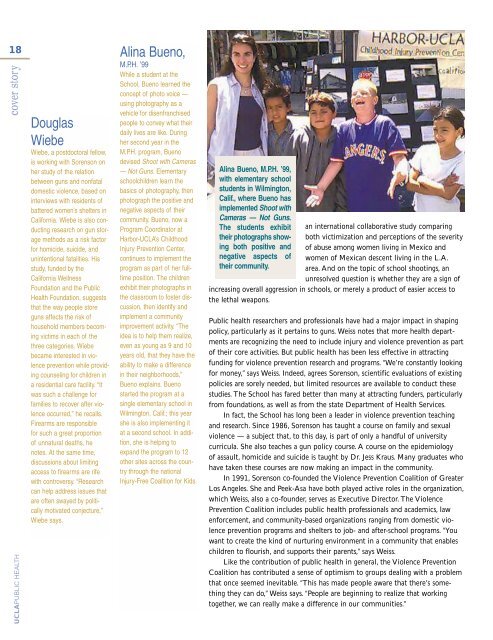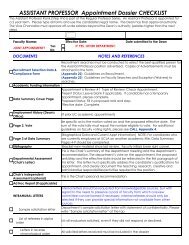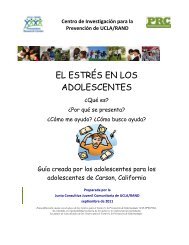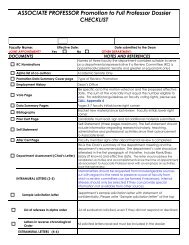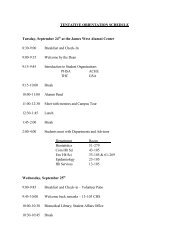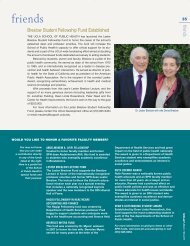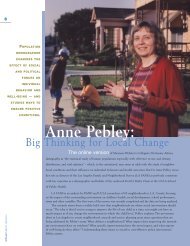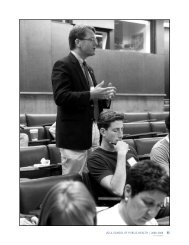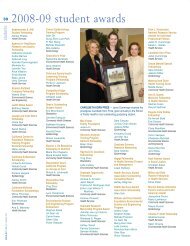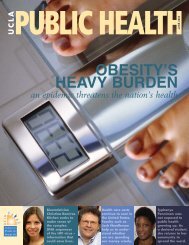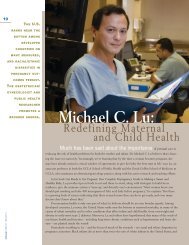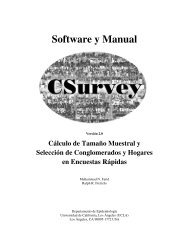JUNE 2001 - UCLA School of Public Health
JUNE 2001 - UCLA School of Public Health
JUNE 2001 - UCLA School of Public Health
Create successful ePaper yourself
Turn your PDF publications into a flip-book with our unique Google optimized e-Paper software.
18<br />
cover story<br />
<strong>UCLA</strong>PUBLIC HEALTH<br />
Douglas<br />
Wiebe<br />
Wiebe, a postdoctoral fellow,<br />
is working with Sorenson on<br />
her study <strong>of</strong> the relation<br />
between guns and nonfatal<br />
domestic violence, based on<br />
interviews with residents <strong>of</strong><br />
battered women’s shelters in<br />
California. Wiebe is also conducting<br />
research on gun storage<br />
methods as a risk factor<br />
for homicide, suicide, and<br />
unintentional fatalities. His<br />
study, funded by the<br />
California Wellness<br />
Foundation and the <strong>Public</strong><br />
<strong>Health</strong> Foundation, suggests<br />
that the way people store<br />
guns affects the risk <strong>of</strong><br />
household members becoming<br />
victims in each <strong>of</strong> the<br />
three categories. Wiebe<br />
became interested in violence<br />
prevention while providing<br />
counseling for children in<br />
a residential care facility. “It<br />
was such a challenge for<br />
families to recover after violence<br />
occurred,” he recalls.<br />
Firearms are responsible<br />
for such a great proportion<br />
<strong>of</strong> unnatural deaths, he<br />
notes. At the same time,<br />
discussions about limiting<br />
access to firearms are rife<br />
with controversy. “Research<br />
can help address issues that<br />
are <strong>of</strong>ten swayed by politically<br />
motivated conjecture,”<br />
Wiebe says.<br />
Alina Bueno,<br />
M.P.H. ’99<br />
While a student at the<br />
<strong>School</strong>, Bueno learned the<br />
concept <strong>of</strong> photo voice —<br />
using photography as a<br />
vehicle for disenfranchised<br />
people to convey what their<br />
daily lives are like. During<br />
her second year in the<br />
M.P.H. program, Bueno<br />
devised Shoot with Cameras<br />
— Not Guns. Elementary<br />
schoolchildren learn the<br />
basics <strong>of</strong> photography, then<br />
photograph the positive and<br />
negative aspects <strong>of</strong> their<br />
community. Bueno, now a<br />
Program Coordinator at<br />
Harbor-<strong>UCLA</strong>’s Childhood<br />
Injury Prevention Center,<br />
continues to implement the<br />
program as part <strong>of</strong> her fulltime<br />
position. The children<br />
exhibit their photographs in<br />
the classroom to foster discussion,<br />
then identify and<br />
implement a community<br />
improvement activity. “The<br />
idea is to help them realize,<br />
even as young as 9 and 10<br />
years old, that they have the<br />
ability to make a difference<br />
in their neighborhoods,”<br />
Bueno explains. Bueno<br />
started the program at a<br />
single elementary school in<br />
Wilmington, Calif.; this year<br />
she is also implementing it<br />
at a second school. In addition,<br />
she is helping to<br />
expand the program to 12<br />
other sites across the country<br />
through the national<br />
Injury-Free Coalition for Kids.<br />
Alina Bueno, M.P.H. ’99,<br />
with elementary school<br />
students in Wilmington,<br />
Calif., where Bueno has<br />
implemented Shoot with<br />
Cameras — Not Guns.<br />
The students exhibit<br />
their photographs showing<br />
both positive and<br />
negative aspects <strong>of</strong><br />
their community.<br />
an international collaborative study comparing<br />
both victimization and perceptions <strong>of</strong> the severity<br />
<strong>of</strong> abuse among women living in Mexico and<br />
women <strong>of</strong> Mexican descent living in the L.A.<br />
area. And on the topic <strong>of</strong> school shootings, an<br />
unresolved question is whether they are a sign <strong>of</strong><br />
increasing overall aggression in schools, or merely a product <strong>of</strong> easier access to<br />
the lethal weapons.<br />
<strong>Public</strong> health researchers and pr<strong>of</strong>essionals have had a major impact in shaping<br />
policy, particularly as it pertains to guns. Weiss notes that more health departments<br />
are recognizing the need to include injury and violence prevention as part<br />
<strong>of</strong> their core activities. But public health has been less effective in attracting<br />
funding for violence prevention research and programs. “We’re constantly looking<br />
for money,” says Weiss. Indeed, agrees Sorenson, scientific evaluations <strong>of</strong> existing<br />
policies are sorely needed, but limited resources are available to conduct these<br />
studies. The <strong>School</strong> has fared better than many at attracting funders, particularly<br />
from foundations, as well as from the state Department <strong>of</strong> <strong>Health</strong> Services.<br />
In fact, the <strong>School</strong> has long been a leader in violence prevention teaching<br />
and research. Since 1986, Sorenson has taught a course on family and sexual<br />
violence — a subject that, to this day, is part <strong>of</strong> only a handful <strong>of</strong> university<br />
curricula. She also teaches a gun policy course. A course on the epidemiology<br />
<strong>of</strong> assault, homicide and suicide is taught by Dr. Jess Kraus. Many graduates who<br />
have taken these courses are now making an impact in the community.<br />
In 1991, Sorenson co-founded the Violence Prevention Coalition <strong>of</strong> Greater<br />
Los Angeles. She and Peek-Asa have both played active roles in the organization,<br />
which Weiss, also a co-founder, serves as Executive Director. The Violence<br />
Prevention Coalition includes public health pr<strong>of</strong>essionals and academics, law<br />
enforcement, and community-based organizations ranging from domestic violence<br />
prevention programs and shelters to job- and after-school programs. “You<br />
want to create the kind <strong>of</strong> nurturing environment in a community that enables<br />
children to flourish, and supports their parents,” says Weiss.<br />
Like the contribution <strong>of</strong> public health in general, the Violence Prevention<br />
Coalition has contributed a sense <strong>of</strong> optimism to groups dealing with a problem<br />
that once seemed inevitable. “This has made people aware that there’s something<br />
they can do,” Weiss says. “People are beginning to realize that working<br />
together, we can really make a difference in our communities.”


